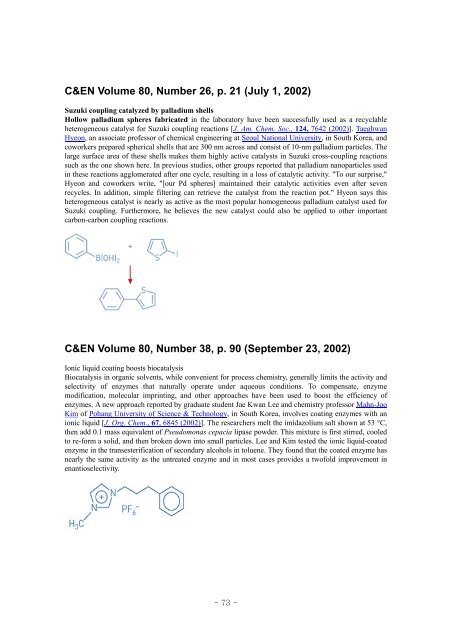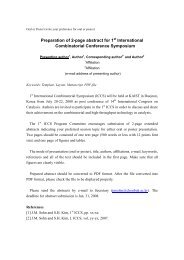Bidding - the International Association of the Catalysis Societies
Bidding - the International Association of the Catalysis Societies
Bidding - the International Association of the Catalysis Societies
Create successful ePaper yourself
Turn your PDF publications into a flip-book with our unique Google optimized e-Paper software.
C&EN Volume 80, Number 26, p. 21 (July 1, 2002)<br />
Suzuki coupling catalyzed by palladium shells<br />
Hollow palladium spheres fabricated in <strong>the</strong> laboratory have been successfully used as a recyclable<br />
heterogeneous catalyst for Suzuki coupling reactions [J. Am. Chem. Soc., 124, 7642 (2002)]. Taeghwan<br />
Hyeon, an associate pr<strong>of</strong>essor <strong>of</strong> chemical engineering at Seoul National University, in South Korea, and<br />
coworkers prepared spherical shells that are 300 nm across and consist <strong>of</strong> 10-nm palladium particles. The<br />
large surface area <strong>of</strong> <strong>the</strong>se shells makes <strong>the</strong>m highly active catalysts in Suzuki cross-coupling reactions<br />
such as <strong>the</strong> one shown here. In previous studies, o<strong>the</strong>r groups reported that palladium nanoparticles used<br />
in <strong>the</strong>se reactions agglomerated after one cycle, resulting in a loss <strong>of</strong> catalytic activity. "To our surprise,"<br />
Hyeon and coworkers write, "[our Pd spheres] maintained <strong>the</strong>ir catalytic activities even after seven<br />
recycles. In addition, simple filtering can retrieve <strong>the</strong> catalyst from <strong>the</strong> reaction pot." Hyeon says this<br />
heterogeneous catalyst is nearly as active as <strong>the</strong> most popular homogeneous palladium catalyst used for<br />
Suzuki coupling. Fur<strong>the</strong>rmore, he believes <strong>the</strong> new catalyst could also be applied to o<strong>the</strong>r important<br />
carbon-carbon coupling reactions.<br />
C&EN Volume 80, Number 38, p. 90 (September 23, 2002)<br />
Ionic liquid coating boosts biocatalysis<br />
Biocatalysis in organic solvents, while convenient for process chemistry, generally limits <strong>the</strong> activity and<br />
selectivity <strong>of</strong> enzymes that naturally operate under aqueous conditions. To compensate, enzyme<br />
modification, molecular imprinting, and o<strong>the</strong>r approaches have been used to boost <strong>the</strong> efficiency <strong>of</strong><br />
enzymes. A new approach reported by graduate student Jae Kwan Lee and chemistry pr<strong>of</strong>essor Mahn-Joo<br />
Kim <strong>of</strong> Pohang University <strong>of</strong> Science & Technology, in South Korea, involves coating enzymes with an<br />
ionic liquid [J. Org. Chem., 67, 6845 (2002)]. The researchers melt <strong>the</strong> imidazolium salt shown at 53 °C,<br />
<strong>the</strong>n add 0.1 mass equivalent <strong>of</strong> Pseudomonas cepacia lipase powder. This mixture is first stirred, cooled<br />
to re-form a solid, and <strong>the</strong>n broken down into small particles. Lee and Kim tested <strong>the</strong> ionic liquid-coated<br />
enzyme in <strong>the</strong> transesterification <strong>of</strong> secondary alcohols in toluene. They found that <strong>the</strong> coated enzyme has<br />
nearly <strong>the</strong> same activity as <strong>the</strong> untreated enzyme and in most cases provides a tw<strong>of</strong>old improvement in<br />
enantioselectivity.<br />
- 73 -



